Table of contents |
| What is innovation? |
| Types of innovation |
| Benefits of innovation |
| Innovation strategy |
| Innovation culture |
| Organization |
| Innovation process |
| Measuring innovation performance |
| Summary |
What is innovation?
“The actions required to create new ideas, processes or products which when implemented lead to positive effective change.”
– Marc Chason, Motorola LabsThis simple definition of innovation captures very well the key attributes of it
- novelty
- execution turns ideas and inventions into innovations
- results in positive change and value
Here is how Marc Chason continues to explore the topic:
“While invention requires the creation of new ideas, processes or products, innovation moves one step further and requires implementation of the inventive act. Innovation also implies a value system which seeks to derive a positive outcome from the inventive act. For example, actions which lead to a negative performance metric would not be considered innovative, even if they met the requirements of novelty and enabling actions.”
The simple definition of innovation thought leader Tim Kastelle concentrates more on the process:
“Innovation is the process of idea management.”
Innovation exists everywhere, but organizations typically want it to be systematic and repeatable and not depending on happenstance. Therefore, we want to stress that successful innovation is a systematic, continuous, process-based approach for organizations that want to succeed in their marketplace by providing enhanced functionality to their customers. The second aspect of innovation that is not covered in the definitions above is the key inputs to the process: business strategy and customer feedback. Therefore, we have compiled the following definition:
“Innovation combines the objectives of organizational strategy and needs of customers to a portfolio of ideas which are actively managed to maximize the positive impact to the organization.”
Innovation is always in the context of an organization. Something which has been implemented somewhere else is still an innovation for an organization that copies it and benefits from the value it creates.
Types of Innovation
In order to distinguish between different types of innovation, several ways to further classify innovations have been proposed.
- incremental innovation; small improvements to the existing offering which support the business continuity of the organization
- differential innovation; new offering for the same markets
- disruptive innovation; offering that takes root initially in simple applications at the bottom of a market and then relentlessly moves up the market, eventually displacing established competitors
- radical innovation; new offering for new markets
- breakthrough innovation; new offering that creates new markets; the new offering typically offers substantially higher customer benefits than the current offering
The terminology for non-incremental innovation is not established and is used inconsistently in many cases. Often words radical, disruptive, and breakthrough are used in a non-consistent way. In this post, radical innovation means all non-incremental innovation.
Arthur D Little has proposed a holistic classification of innovation and linked the impacts of these classes to the P&L of the organization
- transform; grow new markets and new offerings
- enhance; grow in adjacent market areas
- defend; small improvements of existing offerings for example by adding a new feature like machine learning and artificial intelligence
- increase asset or employee productivity with process innovation; increase the efficiency of the organization by redesigning supply chain concept or by solving process bottlenecks
- decrease raw material & energy costs; reformulate ingredients of production

An alternative way of classifying innovation is the three innovation horizons model which was presented in 1999 in the book “The Alchemy of Growth”. Christian Terwiesch and Karl T. Ulrich introduced an updated version of it in their book “Innovation Tournaments”. The model classifies innovations based on technology and markets.

Using three horizons model in organizational innovation management has certain benefits
- it supports linking innovation to strategy; Horizon 2 and 3 efforts should closely align with the targets set in the strategy
- it helps to balance the innovation portfolio; very often almost all innovation efforts are in horizon 1; using three horizons model helps to focus as well on radical innovations in horizons 2 and 3; for example Google uses 70 / 20 / 10 model, where 70 % of efforts are focus on horizon 1, 20 % on horizon 2 and 10 % on horizon 3
Innovation can be classified also according to the object of development. Four identified areas are
- product innovation
- service innovation
- management model or process, i.e. process innovation
- business model
According to PwC 35 % of companies’ first choice for innovation area was products and services. However, the importance of business model innovation is increasing, and it was second on the list with 17 % share.
Lately, there has been increasing focus on developing innovations that take into consideration the specifics of target markets including the income level. One example of this approach is frugal innovation where companies develop more affordable, yet high-quality products for developing countries.
Benefits of innovation
Research and studies link innovativeness to tightly to positive organizational results:
- the shareholder returns of the most innovative companies outperformed the peers by 12.4 percent (Source: Boston Consulting Group)
- innovation drives economic growth: the most innovative 20% of companies grew at a rate 16% higher than the least innovative (Source: PwC)
- top quartile innovation performers obtain on average 13% points more profit from new products and services than average performers (Source: Arthur D. Little)
- the employee Net Promoter score (eNPS) of the top quartile innovation companies is 23, compared with -56 for other companies (Source: Bain & Company)
Innovation strategy
Building strong links between business and innovation strategy has a significant correlation with financial results: companies with more tightly aligned business and innovation strategies had 40 percent higher operating income growth over a three-year period, and 100 percent higher total shareholder returns, than industry peers with lower strategy alignment (Source: Strategy&).
Although strategy aligned Innovation program is so crucial from results perspective, 42 % of the companies studied in 2012 had it. As with business strategy the organization would benefit from understanding it. Almost 80 % of the companies with formal innovation strategies communicate it widely in the organization to ensure alignment in the context of innovation (Source: Capgemini).
Strategy& has analyzed since 2004 annually the innovation practices of the 1000 biggest spending public companies. In 2007 they identified three kinds of companies with a distinct way to manage their innovation process. Strategy& calls these approaches innovation strategies. Even though these strategies are generalizations, they demonstrate the difference that organizations can have in their innovation approach. According to their analysis, every company tends to follow one of the three strategies. They categorize companies as
- need seekers; they use superior insights and learnings about customers to generate innovations; these insights are collected through direct engagement with customers; examples of need seekers are Apple, Procter & Gamble, and Tesla
- market readers; they focus on small improvements on the products that are already in the market; they collect ideas by monitoring closely their market, competitors, and customers; examples of companies with this strategy are Samsung, Caterpillar, and Visteon
- technology drivers; they trust heavily their internal technological capabilities to develop new innovations; they believe that due to their technological competence and insight, they will meet all needs of customers; examples of companies with this strategy are Google, Bosch, and Siemens
The companies following these generic innovation strategies are differentiated by their approach to four critical dimensions of innovation. These dimensions are presented in the figure below (source: Strategy&)
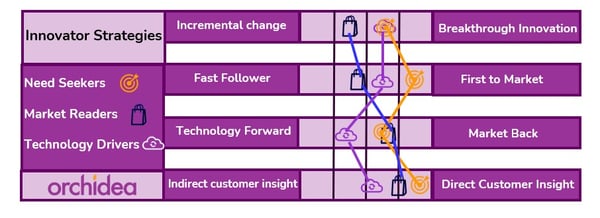
Strategy& believes that all three strategies can be successful if executed well. However, they believe that the Need Seeker strategy is inherently advantaged. A primary reason for the advantage is the strong focus on business innovation as a vital part of the company and its culture. This focus is visible in several areas
- significantly more innovation leads at Need Seekers report directly to the CEO
- their innovation agendas are better communicated to the whole organization
- their business and innovation strategies are better aligned.
The financial analysis of the studied companies also supports the view that the Need Seeker strategy is more successful. 57.6 % of Need Seekers financially outperform their competitors compared to the 46.2 % average of the studied companies. This gave the innovation leader companies a significant competitive advantage.
According to Strategy& a strong focus on capturing customer insights directly from customers had a strong impact on financial results. Companies and innovators which capture insights directly from customers had three times the growth in operating income and twice the return on assets of industry peers that captured customer insights indirectly, as well as 65 percent higher total shareholder returns.
Organizational innovation strategies take many forms, from word documents to 60-slide PowerPoint presentations. The industry, size, and maturity of the organization should also be taken into consideration. Therefore we prefer to list topics that one should think about when preparing a strategy instead of providing a template to fill.
Typical innovation strategy answers the following questions
- How innovation will help to achieve the goals set in business strategy? What kind of innovation initiatives the organization will start in order to support the business strategy?
- How aggressive is the strategy? Is it a defensive “Play not to lose” or a more aggressive “Play to win” strategy aiming at achieving leadership via innovation? The aggressiveness of the approach is derived from the chosen business strategy.
- What drives innovation? Does the organization follow the need seeker, market reader, or technology driver innovation model?
- How much innovation is needed to support the goals? In order to set this, the organization requires an understanding of how the organization’s current innovation funnel works, and what are typical conversion rates at different stages of the funnel.
- What balance of innovation projects is needed? Business goals should include the revenue and margin projections of new and existing products with the different customer and market segments. This information can be converted to corresponding ratios of incremental and radical innovation.
- In which areas should innovation focus on? Product and service, management innovation, and business model innovation.
Innovation culture
Studies of innovation have indicated a strong link between the right kind of culture and innovation success. Combining good cultural support of the innovation and tight alignment of business and innovation strategy appears to be the silver bullet of innovation. Companies that performed strongly on both elements have 30 % higher enterprise value growth and 17 % higher profit growth than the rest of the companies (Source: Strategy&). At the same time, 41 % of respondents in PwC study considered lack of supporting culture to be the 2nd greatest obstacle to being more innovative.
The following cultural attributes are considered important for innovation success
- strong customer focus
- senior executives' participation and commitment to innovation
- openness to inputs from external parties like customers, suppliers, competitors
- tolerance for failure and risk; portfolio approach for risk-taking and ensuring enough radical innovation
- strong well defined innovations process, budget, and governance
- culture of collaboration across functions and geographies; involving employees in innovation initiatives
- recognizing and rewarding innovation
Leaders have an important role in transforming organizational culture. They should analyze to current organizational culture and identify the elements where change is required. Change should be promoted by publicly establishing the desire for new behavior and rewarding and recognizing the right behaviors when they occur. This is of course over-simplistic model for change, but it lays out the high-level logic of it.
After the top leadership has bought into innovation, change management efforts are typically steered towards middle management. Mid-level management involvement has been identified as the primary reason for success in large-scale change and innovation efforts.
One easy way to foster an innovation culture in the organization is by arranging regular innovation challenges. Each challenge invites employees to submit their ideas to the topic of the challenge. Lately, many organizations have spiced up innovation challenges with silicon valley type pitching sessions. In them, top ideas are pitched to internal investors which allocate development funds to the best ones. Learn more about innovation challenges in our blog post Innovation challenge - the complete guide.
At the personal level innovation motivation is assessed to vary based on a person’s position in the organizational hierarchy (Source: Capgemini):
- senior executives were motivated primarily by accountability for realizing growth which is clearly an extrinsic motivator
- employees are primarily motivated for innovation because of intrinsic drives like 1) innovation is considered to be exciting work 2) employees have a desire to improve things
💡Learn more about running innovation challenges on:
Organization
As more organizations are placing innovation on their priority list, it means that formal organization of innovation efforts has been a consistent phenomenon in the last years. As many organizations are taking their first steps in this space, it appears that there is plenty of room for improvement as well. According to Capgemini’s global survey only 30 % of respondents feel that they have an effective organizational structure for innovation. Reported primary challenges are
- not having a formal organizational structure for innovation, 45 %
- not having a well-defined governance structure, 45 %
- lack of clear roles and responsibilities 40 %
Only 43 % of the interviewed organizations in the same Capgemini study said they have a formally accountable innovation executive. We can expect the number to be much higher today as the share had grown 11 percentage points from 2011.
According to Boston Consulting Group there is a growing trend towards a centralized approach to innovation. Two-thirds of the most successful innovators in their study drove all their innovation by centralized innovations team, at least in its initial stages. In some cases, the central organization conducts only the early stages and passes the framework for new products or services to business or regional units for development and launch.
However decentralized organizational structure around innovation is still more dominant. According to PwC, in 72 % of companies, individual product areas or services are responsible for their own innovations. As it is common to have multiple organizational approaches to innovation, 63 % of companies reported in the same study that they drive innovation also centralized across the entire organization.
Tim Kastelle has developed The Innovation Matrix to help organization map their current innovation capability and support in developing it. The matrix has two dimensions
- innovation commitment; it describes the organization’s commitment to innovation which is demonstrated through innovations role in communication and values; it should be visible also in how much resources like time and money are devoted to innovation; generally, it is measuring innovation inputs
- innovation competence; it describes organization ability to generate and execute ideas into innovations; it measures innovation outputs

Another organizational aspect affecting innovation success is diversity. Companies with above median diversity generated 38 % more revenue from new products and services than their peers. Learn more on how diversity can boost innovativeness on our infographic on Innovative leadership.
Innovation process
Some people feel that talking about innovation and process in the same sentence is dangerous. The primary reason for this opinion is that these people are afraid the process kills the creativity part of innovation. Some are also afraid that having an innovation process in place might keep people a false sense of security. Mostly because having a process does not guarantee innovation. These are all valid concerns, however, most innovation practitioners believe that there is a strong link between the formal innovation process and innovation success.
There are certain innovation best practices for success in the innovation process:
- A strong link between business and innovation strategy
- Capturing customer insights directly from customers
- Effective capturing of ideas; companies that rated themselves highly effective in idea generation had 30 % higher earnings as a percentage of revenue than their peers (Source: Strategy&)
- Active management of innovation portfolio throughout the whole journey from research to launched innovations; this includes termination of non-promising projects and balancing the portfolio of incremental and more radical innovations
- Involving the whole personnel in ideation
A properly defined and communicated innovation process has several advantages:
- It creates structure and a common understanding of the process for the personnel
- It helps to focus on the most potential projects
- It monitors the health of the innovation portfolio with regular evaluations
Innovation process is often described at a high level with a funnel. It’s very descriptive because typically the number of items like ideas or projects in the process decrease as the process advances. The primary reason for the decrease is that items are evaluated regularly in the process and in each evaluation only the most potential items are passed through to the next phase. One characteristic of the innovation process is that the further the idea or project advances in the process, the more money and resources are invested into it. Therefore, it is vital to evaluate regularly the likelihood of the returns on these investments.
The benefits of the innovation funnel are
- It supports keeping the innovation portfolio healthy with evaluations and reviews which are typically performed between stages
- It demonstrates visually that we have to make choices in the process and not all ideas can progress to the next stage because each stage requires more resources
- It can be adjusted to meet the needs of each organization
Based on the nature of the business and chosen innovation process, the innovation funnel and process vary between organizations. Below is an example of a funnel which typically used in product development.
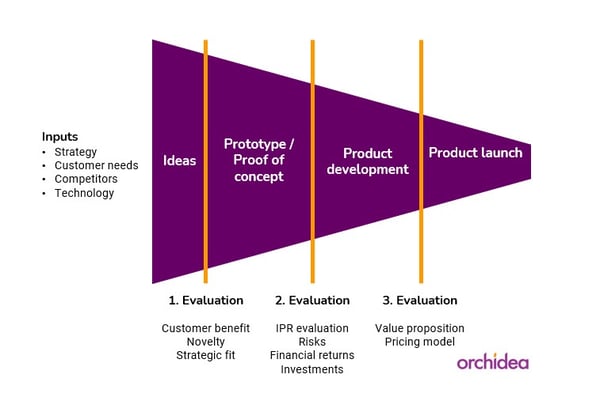
At a more detailed level innovation process can include stages described below. All described stages are not relevant depending on the business, because for example intellectual property rights are typically not managed for services.
- Innovation strategy; it is not really a step in the process, but it merely sets the objectives for the process and should guide the decision-making during it
- Customer and market insights; tools and processes to collect technology, market, and customer insights
- Idea management; Ideas are gathered at all stages of the process and they are evaluated and classified to develop a structured idea bank; approved ideas are fed into the appropriate stages 5, 7, or 8. Nowadays it is common that modern methods like design thinking are used together with traditional ideation methods in the idea management process.
- Portfolio management; based on the combined data from steps 1 and 2, a balanced portfolio of innovation should be developed; it should include short and long-term projects; as failure is an inseparable part of innovation, it is important that the projects at different innovation process stages are managed actively; this does mean only that they monitored, but it also means that they are canceled if appropriate
- Research; when the innovation portfolio is compared to the current status, the gaps become visible and they should be addressed with research
- IPR management; steps to protect and commercialize inventions that have been developed in the innovation process
- Development & launch; all steps required to transform the idea into a launched product, service, process, or business model
- Post-launch; product upgrading and continuous improvement
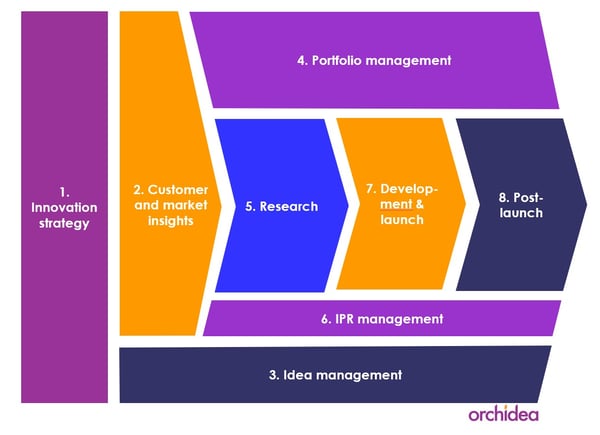
It is typical that the innovation process for radical innovation is more flexible or even different from the rest of the innovations. Examples of this flexibility are (Source: BCG)
- radical innovation projects are permitted to more openly defined project targets; for example 80 % of successful innovators allow radical projects to start without projection of future returns
- radical innovation projects are allowed for more iteration and adjustment of initial plans
- radical innovation projects are hosted in separate organizational entities that allow for easy collaboration with internal and external partners
To succeed in innovation, organizations should also create a system and processes for idea management.
Measuring innovation performance
“Innovation has nothing to do with how many R&D dollars you have. When Apple came up with the Mac, IBM was spending at least 100 times more on R&D. It’s not about money. It’s about the people you have, how you’re led, and how much you get it.” (Steve Jobs, Fortune magazine 1998)
For most organizations, the success of their innovation efforts is measured by the success of their products and services among their customers.
Strategy& has been studying the R&D spending of the biggest R&D spenders annually since 2005. These analytics have shown that there is no statistically significant relationship between sustained financial performance and R&D spending. The only exception to this rule is when the company’s R&D spending falls into the bottom decile compared with its peers. This means that spending on R&D significantly less than your peers increases the risk of less than average financial performance (Source: strategy&).
Many companies are challenged with not having enough radical innovation. In order to tackle this 76 % of the most successful innovators in Boston Consulting Group’s study have linked incentives to radical innovation.
Here is the compilation of the most widely used innovation metrics
- Innovation ROI; incremental margin from innovation initiatives divided by total innovation investments
- Percentage of sales from new offering; widely used metrics which is most often calculated as the percentage of revenue generated from an offering that has been launched in the past three years; the time horizon should be adjusted according to product or services life-cycles in the industry
- Customer satisfaction associated with new offering; how satisfied customers are with a new offering
- Pipeline ECV; aggregated expected commercial value (ECV) of an individual innovation is a net present value measure that has been adjusted for both technical and commercial risk; pipeline ECV is the total value of the organization’s innovation pipeline
- Time to market or development cycle is typically measured between the beginning of offering development and the first market launch
- R&D effectiveness; profit generated from new offerings compared to innovation investments over the same time period
- Projected versus actual revenue performance; degradation of the financial forecast is a common problem when a new offering moves through the development cycle; organizations can improve their forecasting skills by following these metrics from early development to post-launch
- Resource productivity; aggregate pipeline ECV divided by the number of full-time equivalent resources working in the innovation organization
- Innovation portfolio mix and balance; this is not a single metric, but a category of measures that help the organization to assess the health and alignment of the innovation portfolio; typical metrics are share of incremental versus radical innovation initiatives, initiative risk portfolio; ideas, and initiatives by offering and geography and timing of expected innovation returns
- The number of ideas; how many innovative ideas are needed to reach the desired number of successful innovations?
Many of the above-mentioned metrics require a careful definition of used variables and time spans, for example
- how incremental revenue and margin are calculated
- how long is a launched offering considered new and included in the calculations
- what is included in innovation investments and headcount; for example in consumer goods, brand innovation can have a huge impact on growth
- how to classify different innovation types
- how to assess risks
It is important to define the used variables carefully and have the discipline to apply them consistently. It is as well important to realize that most of these metrics are not comparable between organizations due to a lack of standardized definitions.
The best practice in innovation measurement is to collect a cross-functional team to agree on the required estimates like revenue, margin, and risk. This team should take into account the following aspects (Source: Arthur D Little)
- those offering and segment combinations in which current and future offerings compete for similar customers; and how this affects the financials of current and future offerings
- historical rates of margin erosion
- likely offering releases by competitors and the likelihood of disruptive innovations
- anticipated commoditization of existing and future offerings
Summary
Innovation is one of the key drivers behind the growth of the global economy. On the other hand, increasing competition from innovative challengers is forcing organizations of all sizes to focus on innovation and digitalization of their existing businesses. The foundation of systematic innovation is business strategy linked to objectives, supporting culture, and formal organization. The key elements of execution are the innovation process and its key performance indicators. Best practices of innovation execution are efficient and transparent decision-making that has the courage to manage actively the innovation portfolio.
The purpose of this post is to form a high-level summary of innovation. We hope that we succeeded also to demonstrate that innovation is not magic or mystery, but it is a process like any other process. And when it is planned and executed properly, it can have a significant effect on the success of the organization.
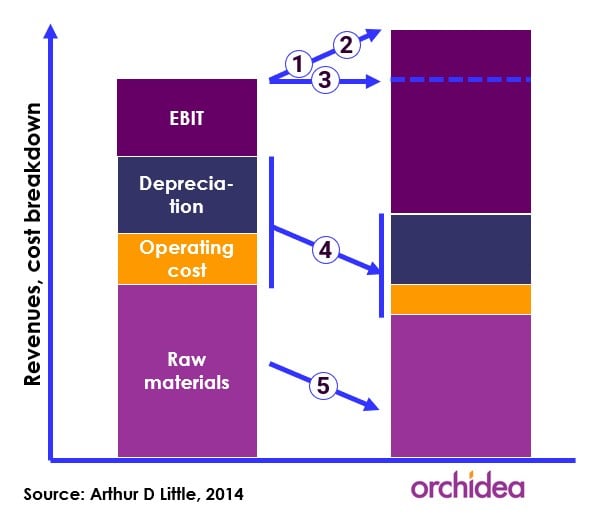





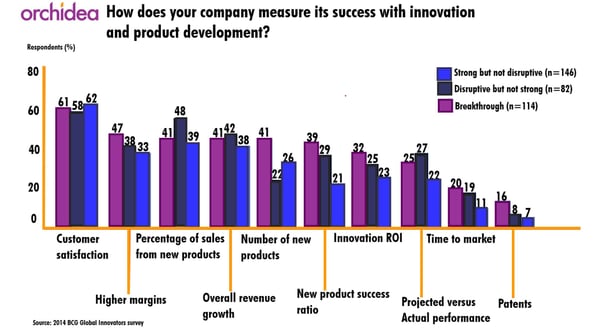
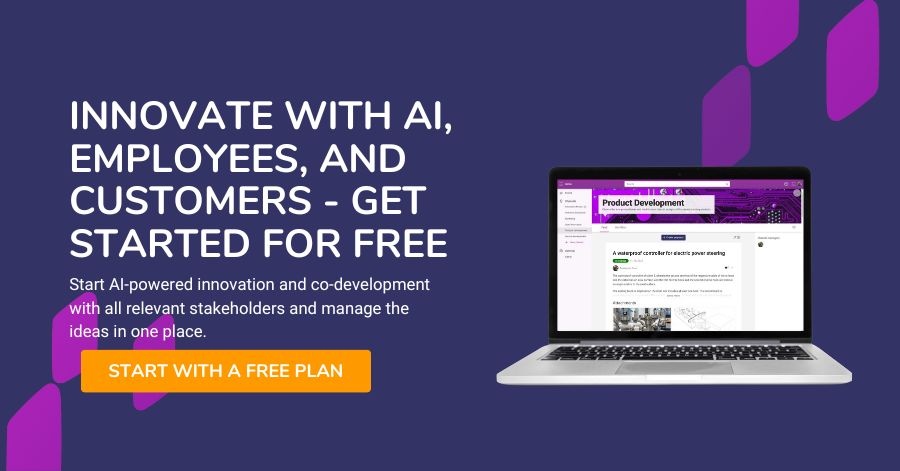
.jpg)
.jpg)
